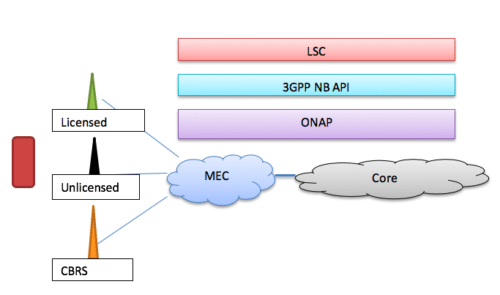5G is about many things, but intrinsic nature of everything’s there would be “scaling up”, whether it be performance KPIs, uses of spectrum, more technology accommodation, operation, management or orchestrations, all need to be scaled up, and that is something about “large scale convergence” or LSC. 5G will be all about convergence, it will be defined by it and it will define it too, new dimensions, large abstractions etc. etc. we call it “Large scale convergence” or LSC.
As from industry view, Boingo CTO says, “Beware…convergence is the future! Ubiquitous 5G is not economically practical without coexistence between licensed, unlicensed and shared. Mobile connectivity is no longer a device, it’s a lifestyle so we must embrace converged solutions that leverage multiple bands and technologies”.
5G is also being seen as the catalyst for industry 4.0, i.e. new industrial revolution, which will essentially set the paradigm of “Everywhere and Everything Connectivity”. This ‘large-scale phenomena’ will not appear in a sudden, it will take approaches to form.
So how 5G will evolve, it will go through two separate approaches altogether. let me take the nomenclature form algorithmic world.
1 A greedy approach, an approach focus to solve the specific problem.
2. Dynamic approach, an approach, generic in sense and address the problem with large vision.
Greedy approaches will move there at beginning first and will keep continuing with new applications, early approaches take footage during 2018-2022, like 5G in fixed wireless, LTE assisted network.
Dynamic approach will be the real transformation into a complete system of 5G. This is where the concept of ‘large scale convergence’ or LSC comes from. The real period of focus will go from 2020 to 2025.
LSC “Large scale convergence” is not about the convergence of different technology only, in terms of technical interworking, but a comprehensive framework which will allow and enable to deliver the service as per the requirement of various applications. It is about providing the end user what they need based on their requirements and applicability of 5G networks. There was an eminent need for a right platform to create such framework.
The technologies, which going to make this LSC possible are emerging fast and being adopted by ecosystem players across the globe. These technologies are those one’s which providing harmonization among ecosystem players, and much-required facilitation for convergence. These are….
ONAP
ONAP (Open Network Automation Platform) is an open source software platform that delivers capabilities for the design, creation, orchestration, monitoring, and lifecycle management of Virtual Network Functions (VNFs), carrier-scale Software Defined Networks (SDNs), higher-level services that combine the above. Being under the ownership of Linux Foundation and originally the ECOMP from AT&T, it provides automatic, policy-driven interaction of these functions and services in a dynamic, real-time cloud environment. ONAP is not just a run-time platform; it includes graphical design tools for function/service creation.
ONAP essentially provides harmonized development, service orchestration, and continuous life cycle management.
VNF
Virtual network functions and Software-defined networks brings the required adoptability. The need is for right framework for their harmonization and interoperability. A well-orchestrated network can cater the large-scale abstraction from the application demand. So the vendor should care for it in the development of VNF and SDNs.
MEC
MEC is the kingpin in the facilitation of this “large-scale convergence”, in fact, we think that MEC will be defined through that as well. The point is that VNF and MEC will act like a suit for upcoming 5G architecture.
MEC brings application specific affinity in the 5G, which going to be application defined network in any way. This application-specific affinity is much demanding point for large scale convergence.
Also virtualization is required End to End, for economical as well as political reasons. Those are also kind of factor going to define and place MEC.
3GPP North Bound APIs
A Northbound API is an interface between an Application Server and the 3GPP system via specified Functions in a mobile operator’s network. To realize standardized integration of services with diverse service providers, northbound APIs provide for interaction at the application layer. This makes it possible for mobile network operators to offer a wide range of services beyond prevalent teleservices – voice calls, SMS and data service. Those services can be exposed within the operator network or to third parties in other networks.
Standardization of northbound API is already there, in 3GPP Release 14, the “eMBMS Delivery of Media and TV Services” feature provide broadcasters with the ability to directly integrate their services with mobile network operators over standardized interfaces to the 3GPP system. Also in Release 15, 3GPP will include functionality to directly expose Cellular IoT and MTC capabilities via northbound APIs.
3GPP is also working for Common API Framework (FS_CAPIF), focusing on common aspects of northbound APIs. Mainly about architectural aspects such as registration, discovery and identity management that generally apply to all services. Common API Framework Functions could be achieved uniformly for such capabilities as Service API discovery, monitoring and charging.
FS_CAPIF takes into account both the work ongoing within 3GPP as well as frameworks defined by other organizations. It aims to provide recommendations for specific architectural solutions that can subsequently be standardized.
Back to LSC
- LSC is about the felicitation to make 5G – Application defined network.
- LSC provides – homogeneous connectivity through heterogeneous networks, an E2E defined paradigm incorporating multiple access technologies.
- LSC is about to have a comprehensive E2E approach while setting a 5G network.
- LSC facilitate required abstraction to address versatile dimensions of various applications.
- LSC is a felicitation to define the 5G landscape and network slicing.






